人教版八年级英语下册第九单元教案
- 格式:pdf
- 大小:53.69 KB
- 文档页数:8
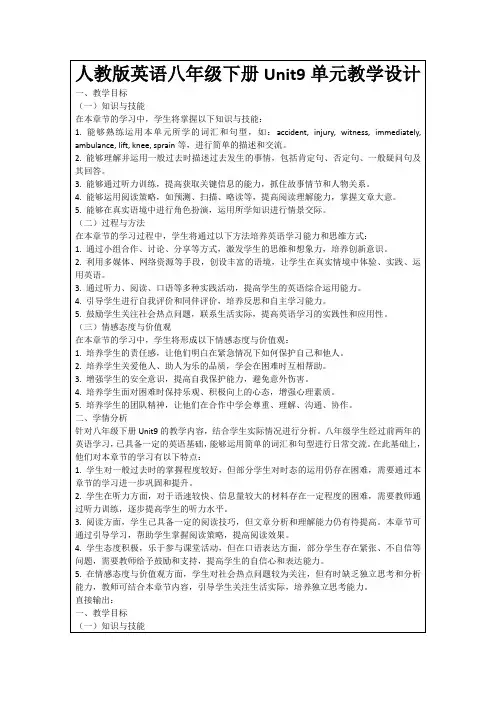
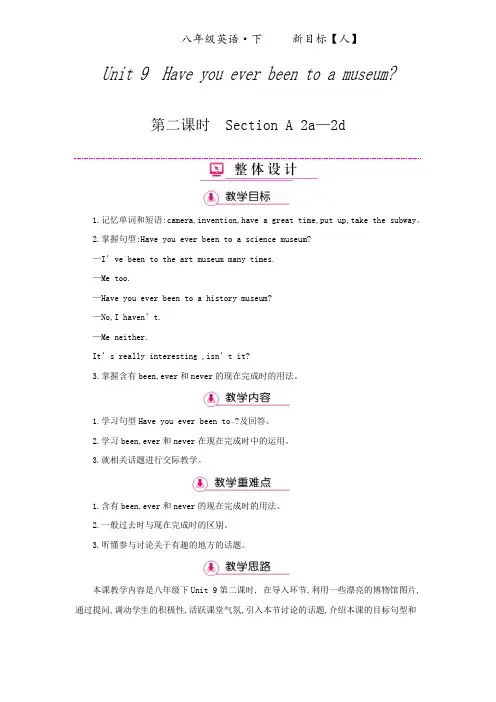
八年级英语·下新目标【人】Unit 9 Have you ever been to a museum?第二课时Section A 2a—2d1.记忆单词和短语:camera,invention,have a great time,put up,take the subway。
2.掌握句型:Have you ever been to a science museum?—I’ve been to the art museum many times.—Me too.—Have you ever been to a history museum?—No,I haven’t.—Me neither.It’s really interesting ,isn’t it?3.掌握含有been,ever和never的现在完成时的用法。
1.学习句型Have you ever been to…?及回答。
2.学习been,ever和never在现在完成时中的运用。
3.就相关话题进行交际教学。
1.含有been,ever和never的现在完成时的用法。
2.一般过去时与现在完成时的区别。
3.听懂参与讨论关于有趣的地方的话题。
本课教学内容是八年级下Unit 9第二课时, 在导入环节,利用一些漂亮的博物馆图片,通过提问,调动学生的积极性,活跃课堂气氛,引入本节讨论的话题,介绍本课的目标句型和单词,在听力环节,注重对学生听力策略的指导,消除学生对听力的“恐惧”心理,让学生能够高效做题。
2d教学是本课综合运用的体现。
通过学习词组、重点句到对话的填空让学生的学习有渐进的过程;抽取学生进行角色扮演,对学生是知识升华的过程。
设计教学PPT,录音机,图片,多媒体。
StepⅠ.Lead in[设计意图]调动学生情感,激活他们头脑中关于过去去过的地方的情感,导入新授。
Leading inT:Boys and girls,do you like traveling?S:Yes.T:Great! Most of you like traveling very much.Me too.Look at the pictures.I went to a lot of places last year.Guess where I went? Use “have/has been to”.S1:You have been to Shanghai.S2:I know you have been to the space museum.S3:You have been to the amusement park.S4:You have been to the zoo.S5:…T:Great! All of you did well.I have been to so many interesting places.Which of these places would you like to visit? Please rank them 1 to 6.space museumhistory museumart museumwater parkzooamusement parkS:…[设计意图]通过情境引入,激发学生情感,便于导入新授内容。
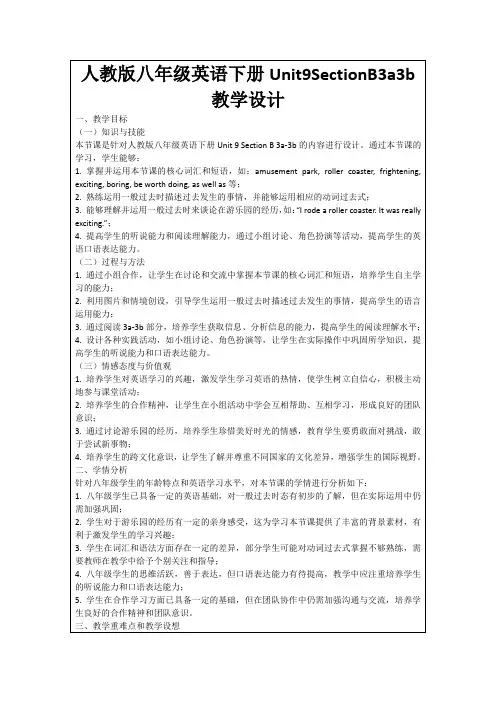
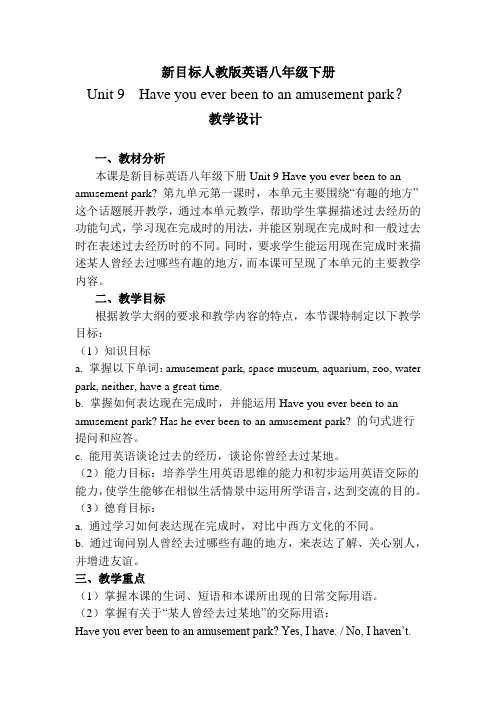
新目标人教版英语八年级下册Unit 9 Have you ever been to an amusement park?教学设计一、教材分析本课是新目标英语八年级下册Unit 9 Have you ever been to an amusement park? 第九单元第一课时,本单元主要围绕“有趣的地方”这个话题展开教学,通过本单元教学,帮助学生掌握描述过去经历的功能句式,学习现在完成时的用法,并能区别现在完成时和一般过去时在表述过去经历时的不同。
同时,要求学生能运用现在完成时来描述某人曾经去过哪些有趣的地方,而本课可呈现了本单元的主要教学内容。
二、教学目标根据教学大纲的要求和教学内容的特点,本节课特制定以下教学目标:(1)知识目标a. 掌握以下单词:amusement park, space museum, aquarium, zoo, water park, neither, have a great time.b. 掌握如何表达现在完成时,并能运用Have you ever been to an amusement park? Has he ever been to an amusement park? 的句式进行提问和应答。
c. 能用英语谈论过去的经历,谈论你曾经去过某地。
(2)能力目标:培养学生用英语思维的能力和初步运用英语交际的能力,使学生能够在相似生活情景中运用所学语言,达到交流的目的。
(3)德育目标:a. 通过学习如何表达现在完成时,对比中西方文化的不同。
b. 通过询问别人曾经去过哪些有趣的地方,来表达了解、关心别人,并增进友谊。
三、教学重点(1)掌握本课的生词、短语和本课所出现的日常交际用语。
(2)掌握有关于“某人曾经去过某地”的交际用语:Hav e you ever been to an amusement park? Yes, I have. / No, I haven’t.Has he ever been to an amusement park? Yes, he has. / No, he hasn’t.四、教学难点(1)熟练掌握和灵活运用现在完成时来描述某人曾经去过某地。
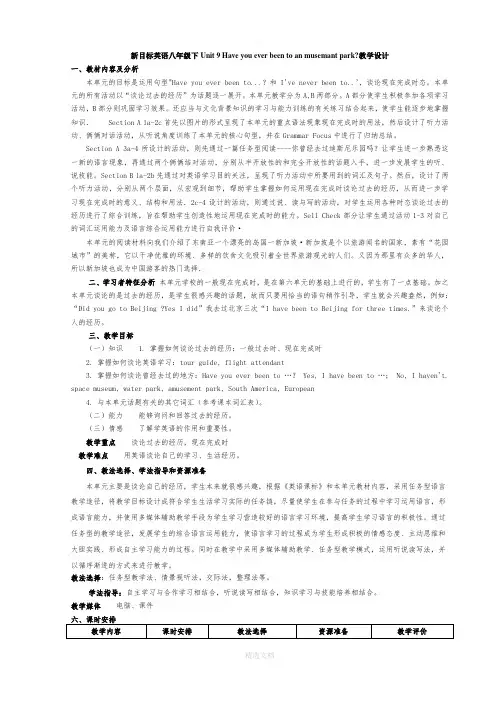
新目标英语八年级下Unit 9 Have you ever been to an musemant park?教学设计一、教材内容及分析本单元的目标是运用句型"Have you ever been to...?和I've never been to..’,谈论现在完成时态。
本单元的所有活动以“谈论过去的经历”为话题逐一展开。
本单元教学分为A,B两部分。
A部分使学生积极参加各项学习活动,B部分则巩固学习效果。
还应当与文化背景知识的学习与能力训练的有关练习结合起来,使学生能逐步地掌握知识. Section A la-2c首先以图片的形式呈现了本单元的重点语法现象现在完成时的用法,然后设计了听力活动、俩俩对话活动,从听说角度训练了本单元的核心句型,并在Grammar Focus中进行了归纳总结。
Section A 3a-4所设计的活动,则先通过一篇任务型阅读----你曾经去过迪斯尼乐园吗?让学生进一步熟悉这一新的语言现象,再通过两个俩俩结对活动,分别从半开放性的和完全开放性的话题入手,进一步发展学生的听、说技能。
Section B la-2b先通过对英语学习目的关注,呈现了听力活动中所要用到的词汇及句子。
然后,设计了两个听力活动,分别从两个层面,从宏观到细节,帮助学生掌握如何运用现在完成时谈论过去的经历,从而进一步学习现在完成时的意义、结构和用法.2c-4设计的活动,则通过说、读与写的活动,对学生运用各种时态谈论过去的经历进行了综合训练,旨在帮助学生创造性地运用现在完成时的能力。
Sell Check部分让学生通过活动1-3对自己的词汇运用能力及语言综合运用能力进行自我评价·本单元的阅读材料向我们介绍了东南亚一个漂亮的岛国一新加坡·新加坡是个以旅游闻名的国家,素有“花园城市”的美称,它以干净优雅的环境、多样的饮食文化吸引着全世界旅游观光的人们。
又因为那里有众多的华人,所以新加坡也成为中国游客的热门选择.二、学习者特征分析本单元学校的一般现在完成时,是在第六单元的基础上进行的,学生有了一点基础。
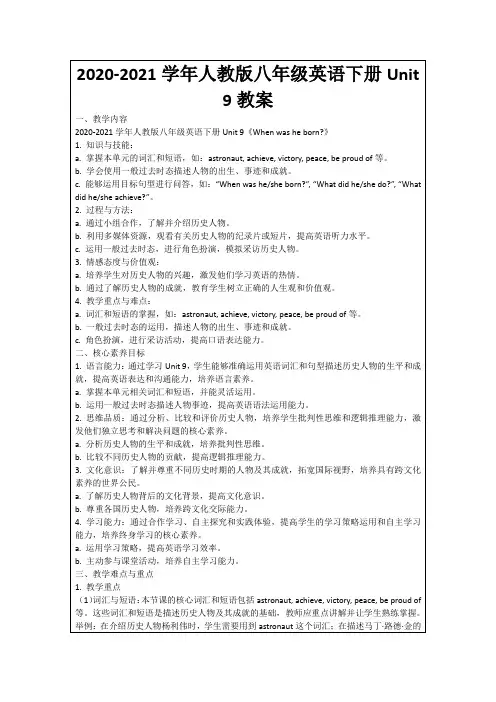
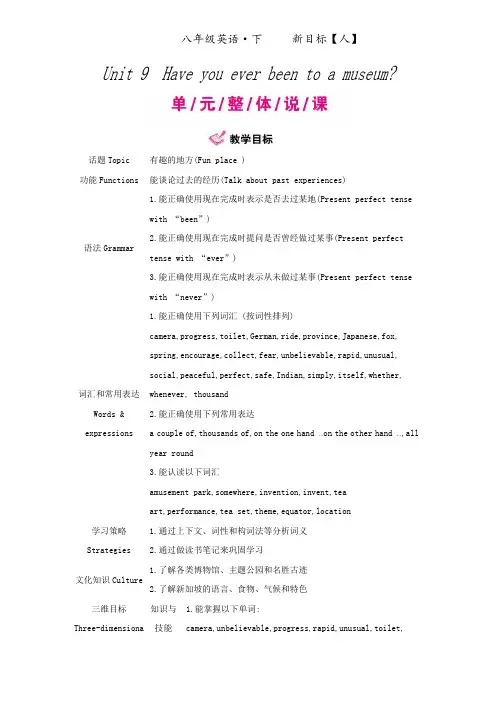
八年级英语·下新目标【人】Unit 9 Have you ever been to a museum?话题Topic 有趣的地方(Fun place )功能Functions 能谈论过去的经历(Talk about past experiences)语法Grammar 1.能正确使用现在完成时表示是否去过某地(Present perfect tense with “been”)2.能正确使用现在完成时提问是否曾经做过某事(Present perfect tense with “ever”)3.能正确使用现在完成时表示从未做过某事(Present perfect tense with “never”)词汇和常用表达Words & expressions 1.能正确使用下列词汇 (按词性排列)camera,progress,toilet,German,ride,province,Japanese,fox, spring,encourage,collect,fear,unbelievable,rapid,unusual, social,peaceful,perfect,safe,Indian,simply,itself,whether, whenever, thousand2.能正确使用下列常用表达a couple of,thousands of,on the one hand …on the other hand …,all year round3.能认读以下词汇amusement park,somewhere,invention,invent,teaart,performance,tea set,theme,equator,location学习策略Strategies 1.通过上下文、词性和构词法等分析词义2.通过做读书笔记来巩固学习文化知识Culture1.了解各类博物馆、主题公园和名胜古迹2.了解新加坡的语言、食物、气候和特色三维目标Three-dimensiona 知识与技能1.能掌握以下单词:camera,unbelievable,progress,rapid,unusual,toilet,l target encourage,social,peaceful,perfect,itself,collect, German,ride,province,thousand,safe,simply,fear, whether,Indian,Japanese,fox,whenever,spring,mostly2.熟练掌握短语:a couple of,have been to,thousands of,Southeast Asia,on the one hand …on the other hand …,the GreatWall,encourage sb. to do sth.,three quarters,all year round3.能掌握以下句型:Have you ever been to a science museum?—I’ve been to the art museum many times.—Me too.—Have you ever been to a history museum?—No,I haven’t.—Me neither.On the one hand,more than three quarters of the population are Chinese,….On the other hand,Singapore is an English-speaking country,…Whether you like Indian food,Western food or Japanese food,you’ll find it all in Singapore!4.掌握含有been,ever,never的现在完成时以及与一般过去时的区别。
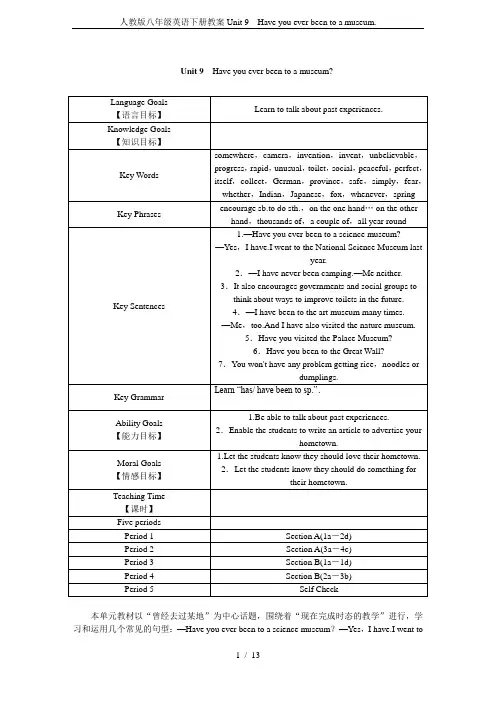
Unit 9Have you ever been to a museum?本单元教材以“曾经去过某地”为中心话题,围绕着“现在完成时态的教学”进行,学习和运用几个常见的句型:—Have you ever been to a science museum?—Yes,I have.I went tothe National Science Museum last year./—I have never been camping.—Me neither./It also encourages governments and social groups to think about ways to improve toilets in the future./—I have been to the art museum many times.—Me,too.And I have also visited the nature museum.等。
在学习过程中,学生在交流中,能促进师生之间的感情。
Section A主要学习几个常见的动词短语及句型Have you been to…?应掌握句型:—Have you ever been to a science museum?—Yes,I have.I went to the National Science Museum last year.等。
通过一篇短文介绍了学生们曾经去过的最有趣的博物馆,增加了学生的阅读量。
Section B安排了听、说、读、写的任务,通过短文“Singapore—A Place You Will Never Forget!”介绍了新加坡的一些情况。
教师在教学中应合理利用课本上的知识进行教学。
第一课时Section A(1a-2d)Teaching Key Points【教学重点】The vocabulary:amusement,somewhere,camera,invention,history/space/art museum,put up,have a good time,water/amusement parkTarget language:1.—Have you ever been to a science museum?—Yes,I have.I went to the National Science Museum last year.2.I have never been camping.3.It's a great way to spend a Saturday afternoon.Teaching Difficult Points【教学难点】Use the target language above to talk about past experiences.Teaching Aids【教学工具】an English book,a tape recorder and CAITeaching Steps【教学过程】★Step 1Preview and perception【预习感知】Ask the students to read the vocabulary and target language.Ⅰ.英译汉。
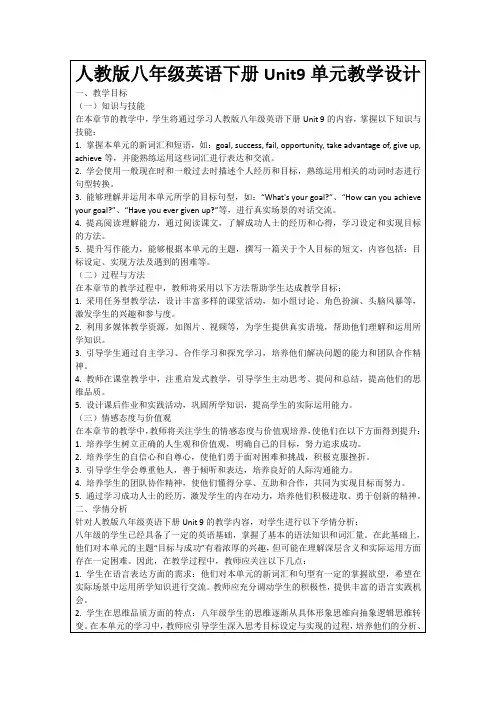
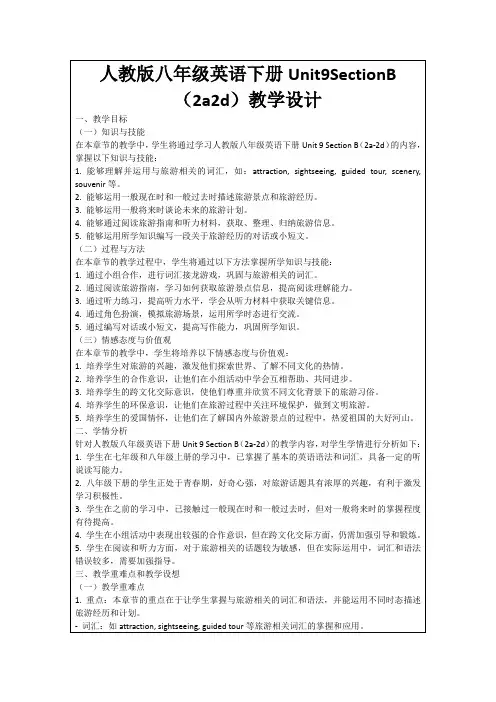
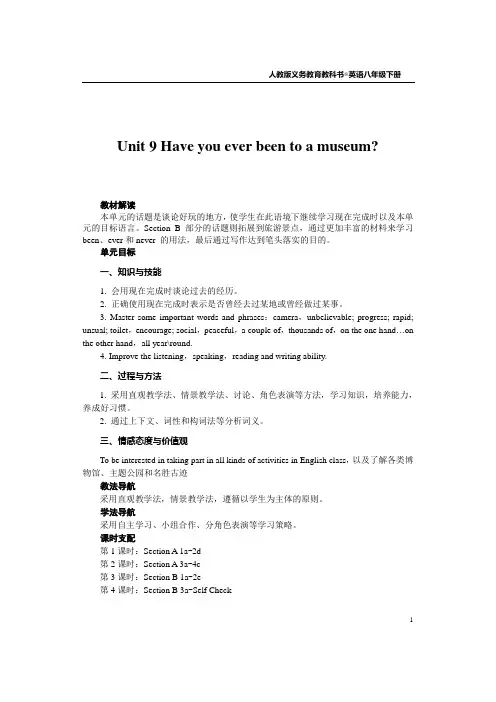
Unit 9 Have you ever been to a museum?教材解读本单元的话题是谈论好玩的地方,使学生在此语境下继续学习现在完成时以及本单元的目标语言。
Section B 部分的话题则拓展到旅游景点,通过更加丰富的材料来学习been、ever和never 的用法,最后通过写作达到笔头落实的目的。
单元目标一、知识与技能1. 会用现在完成时谈论过去的经历。
2. 正确使用现在完成时表示是否曾经去过某地或曾经做过某事。
3. Master some important words and phrases:camera,unbelievable; progress; rapid; unsual; toilet,encourage; social,peaceful,a couple of,thousands of,on the one hand…on the other hand,all year\round.4. Improve the listening,speaking,reading and writing ability.二、过程与方法1. 采用直观教学法、情景教学法、讨论、角色表演等方法,学习知识,培养能力,养成好习惯。
2. 通过上下文、词性和构词法等分析词义。
三、情感态度与价值观To be interested in taking part in all kinds of activities in English class,以及了解各类博物馆、主题公园和名胜古迹教法导航采用直观教学法,情景教学法,遵循以学生为主体的原则。
学法导航采用自主学习、小组合作、分角色表演等学习策略。
课时支配第1课时:Section A 1a-2d第2课时:Section A 3a-4c第3课时:Section B 1a-2e第4课时:Section B 3a-Self Check1课时教案第1课时Section A 1a-2d教学目标一、知识与技能1. Key vocabulary:amusement; neither.2. Listening practice.3. Target language:Lets’ go somewhere different today.Have you ever been to…? Yes,I have./ No,I haven’t.How about/what about…?How are we going to get there?We can take the subway/…4. To train students’ listening and speaking skills.二、过程与方法采用直观教学法,情景教学法,小组讨论与交流来认识并掌握目标语言。
Unit 9 Have you ever been to a museum?第一课时Section A (1a2d)【学习目标】1.重点单词:amusement2.重点短语:have/has been to,have/has gone to3.重点句式:Have you ever been to a museum?Let's go somewhere different today.Frank's friend has never been to the water park.Have you ever been there?It's a great way to spend a Saturday afternoon.I learned about the inventions that led to color movies,too. We put up a tent and cooked outside.I've never been camping.【学习重点】1.重点短语和句型2.have has been to 和have has gone to 的用法3.现在完成时态【学习难点】1.have has been to 和have has gone to 的用法2.现在完成时态【自主学习】一、预习课本P6566新单词并背诵,完成下面的汉译英。
1.娱乐二、认真预习1a2d,找出下列短语和句型。
1.去过某地2.去了某地3.你曾经去过博物馆吗?4.今天让我们去一些不同的地方吧。
5.Frank的朋友从来没有去过水上公园。
6.你去过那里吗?7.这是一个度过周六下午的好方法。
8.我了解到了有关那个导致彩色电影出现的发明。
9.我们支起了一个帐篷并且野炊。
10.我从来没有野营过。
【课堂导学】Step 1情景导入(Show the pictures of amusement parks,water parks,space museums,zoos art museums,and history museums)Teacher:What can you see in the picture?(Look at the pictures and brainstorm the words they can think of,such as space museum,amusement park,water park,zoo,art museum and history museum.)T:Have you ever been to an amusement park?Ss:No.T:Now,we'll learn Unit 9—Have you ever been to a museum?环节说明:通过多媒体图画的谈论问答,并因势引导,采用师生之间的交流方式,自然导入“Have you ever been to a museum?”(“你曾经去过某地吗?”)这一话题。
人教版八年级英语下册第九单元教案Using the present perfect XXX.4.Writing practice.二、过程与方法1.Direct teaching method。
XXX。
n。
role-playing。
etc.2.Analyzing word meanings through context。
word types。
and word XXX.三、情感态度与价值观XXX.教学重点1.Understanding and using the present perfect XXX.2.Learning and using key vocabulary。
XXX.教学难点1.Distinguishing een the present perfect tense and the simple past tense.ing the present perfect XXX.教学过程Step 1: Lead-inAsk the students if they have ever been to an amusement park or museum。
and if they enjoyed it。
Encourage them to share their experiences.Step 2: XXXIntroduce the present perfect tense and explain its XXX examples and ask the students to XXX.Step 3: PracticeHave the students listen to the recordingXXX using the present perfect tense.Step 4: nAsk the students to write a short paragraph about their own experiences using the present perfect XXX them to use the key XXX.Step 5: Review and SummaryReview the XXX lesson。
人教版八年级英语下册第九单元教案
教学目标
- 研究掌握单词和表达方式
- 增强听、说、读、写能力
- 研究了解美国文化和俗
教学内容
1. 单词和短语:包括与家庭和乡村生活相关的词汇。
2. 句型:研究掌握描述家庭和乡村生活的句子结构。
3. 阅读:阅读关于美国家庭和乡村生活的文章,并进行相关讨论。
教学步骤
1. 复:通过图片和单词卡片复之前学过的与家庭和乡村生活相关的词汇。
2. 情景导入:通过展示图片或观看视频介绍美国家庭和乡村生活的一些特点和俗。
3. 新课呈现:学生通过听老师讲解和模仿老师的表达方式,研究掌握描述家庭和乡村生活的句子结构和常用单词和短语。
4. 句型操练:学生进行小组活动,在小组内互相练使用所学的
句子和词汇。
5. 阅读理解:学生阅读一篇关于美国家庭和乡村生活的文章,
并回答相关问题。
6. 讨论与分享:学生就阅读的文章展开讨论,并与同伴分享自
己对于美国文化和俗的理解。
7. 练与巩固:学生进行课堂练,包括填空、选择题等。
8. 总结与提升:教师与学生共同总结本节课的重点内容和难点,并提出下节课的研究目标。
默写测试
在课后,对学生进行一次默写测试,考察他们对于本节课所学
内容的掌握情况。
教学评价
通过观察学生在课堂上的口语表达和默写测试的结果,来评价
他们对于本节课所学内容的掌握情况并给予反馈。
参考资料
- 人教版八年级英语下册教材
- 外语教学与研究杂志。
Section A 单词camera n.照相机;摄影机;摄像机unbelievable adj.难以置信的;不真实的progress v.&n.进步;进展rapid adj.迅速的;快速的unusual adj.特别的;不寻常的toilet n.坐便器;厕所encourage v.鼓励social adj.社会的peaceful adj.和平的;安宁的perfect adj.完美的;完全的itself pron.它自己collect v.收集;采集German adj.德国的;德语的;德国人的n.德语;德国人ride n.供乘骑的游乐设施;短途旅程province n.省份amusement n.娱乐;游戏somewhere adv.在某处;到某处invention n.发明;发明物invent v.发明;创造performance n.表演;演出theme n.主题短语amusement park游乐场lead to导致put up搭起think about考虑make tea沏茶tea art 茶艺tea set茶具equator n.赤道短语take a holiday度假three quarters四分之三at night在夜晚all year round全年be close to 靠近be far from远离……thousands of 数以千计的;许许多多的whether…or…不管……还是……on the one hand…on the other hand…一方面……另一方面……句型1.On the one hand,more than three quarters of the population are Chinese,so you can simply speak Putonghua a lot of the time. On the other hand,Singapore is an English-speaking country,so it’s also a good place to practice your English! 一方面,超过四分之三的人口是华裔,因此很多时候你可以只说普通话。